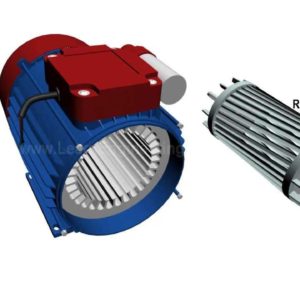single phase induction motors require just one power phase for its operation they are found in domestic as well as industrial use main components of single phase motors are as follows a rotor which is a rotating part a stator winding which is stationary it has got two parts one main winding and one auxilary winding auxiliary winding is placed perpendicular to the main winding a capacitor is connected in auxilary winding let's assume there is only one coil in main and auxiliary winding to understand it's working better assume no current is flowing through auxilary winding a see current passing through main winding will produce a fluctuating magnetic field working a single-phase induction motor is simple just put one rotor which is already rotating inside such a magnetic field you can note one interesting thing the rotor will keep on rotating in the same direction the reason is as follows the fluctuating field is equivalent to sum of two oppositely rotating magnetic fields this concept is known as double revolving field theory affective rotating magnetic field on rotor is interesting since magnetic field is varying electricity is induced in rotor bars due to electromagnetic induction so here is a situation of current-carrying bars are immersed in magnetic field this will produce a force according to Lawrence law so rotor will start rotating but here we have got two such oppositely rotating magnetic fields so torques produced by them will be equal and opposite net effect will be zero torque on rotor so rotor won't start it will simply buzz but if we can somehow give this rotor an initial rotation one torque will be greater than other there will be a net torque in same direction of initial rotation as a result the loop will keep on rotating in the same direction this is the way single phase induction motors work but one big problem remains how to provide such an initial rotation Nikola Tesla a famous Yugoslav inventor suggested one ingenious solution to this problem if we can cancel any of the rotating fields we will be able to start the motor the auxiliary winding come capacitor arrangement is used exactly for this purpose auxilary winding also produces two oppositely revolving magnetic fields one of them will cancel RMF of main winding and other will it get added up resultant will be a single magnetic field which revolves under specific speed such a magnetic field can give starting torque to the rotor or the motor will cell start after the rotor has attained a specific speed even if you cut the auxiliary winding it will keep on rotating as explained earlier this cutting action is done through a centrifugal switch that's all about working of single-phase motors thank you


